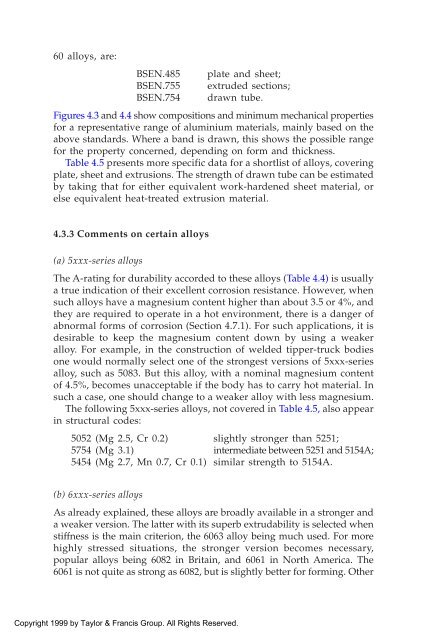Aluminium Design and Construction John Dwight
Aluminium Design and Construction John Dwight
Aluminium Design and Construction John Dwight
You also want an ePaper? Increase the reach of your titles
YUMPU automatically turns print PDFs into web optimized ePapers that Google loves.
60 alloys, are:<br />
BSEN.485 plate <strong>and</strong> sheet;<br />
BSEN.755 extruded sections;<br />
BSEN.754 drawn tube.<br />
Figures 4.3 <strong>and</strong> 4.4 show compositions <strong>and</strong> minimum mechanical properties<br />
for a representative range of aluminium materials, mainly based on the<br />
above st<strong>and</strong>ards. Where a b<strong>and</strong> is drawn, this shows the possible range<br />
for the property concerned, depending on form <strong>and</strong> thickness.<br />
Table 4.5 presents more specific data for a shortlist of alloys, covering<br />
plate, sheet <strong>and</strong> extrusions. The strength of drawn tube can be estimated<br />
by taking that for either equivalent work-hardened sheet material, or<br />
else equivalent heat-treated extrusion material.<br />
4.3.3 Comments on certain alloys<br />
(a) 5xxx-series alloys<br />
The A-rating for durability accorded to these alloys (Table 4.4) is usually<br />
a true indication of their excellent corrosion resistance. However, when<br />
such alloys have a magnesium content higher than about 3.5 or 4%, <strong>and</strong><br />
they are required to operate in a hot environment, there is a danger of<br />
abnormal forms of corrosion (Section 4.7.1). For such applications, it is<br />
desirable to keep the magnesium content down by using a weaker<br />
alloy. For example, in the construction of welded tipper-truck bodies<br />
one would normally select one of the strongest versions of 5xxx-series<br />
alloy, such as 5083. But this alloy, with a nominal magnesium content<br />
of 4.5%, becomes unacceptable if the body has to carry hot material. In<br />
such a case, one should change to a weaker alloy with less magnesium.<br />
The following 5xxx-series alloys, not covered in Table 4.5, also appear<br />
in structural codes:<br />
5052 (Mg 2.5, Cr 0.2) slightly stronger than 5251;<br />
5754 (Mg 3.1) intermediate between 5251 <strong>and</strong> 5154A;<br />
5454 (Mg 2.7, Mn 0.7, Cr 0.1) similar strength to 5154A.<br />
(b) 6xxx-series alloys<br />
As already explained, these alloys are broadly available in a stronger <strong>and</strong><br />
a weaker version. The latter with its superb extrudability is selected when<br />
stiffness is the main criterion, the 6063 alloy being much used. For more<br />
highly stressed situations, the stronger version becomes necessary,<br />
popular alloys being 6082 in Britain, <strong>and</strong> 6061 in North America. The<br />
6061 is not quite as strong as 6082, but is slightly better for forming. Other<br />
Copyright 1999 by Taylor & Francis Group. All Rights Reserved.















